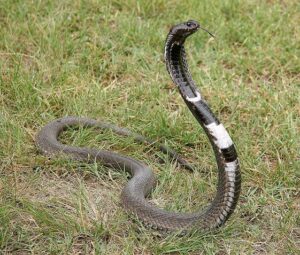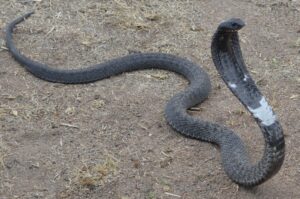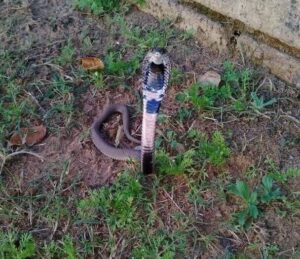The rinkhals, also known as the ringhals or ring-necked spitting cobra, is a highly venomous snake and is the only species in its monotypic genus, ‘Hemachatus‘. Their name is an Afrikaans word that translates to ‘ring neck’. Their name is given due to the pale bands on their throat.
Despite some similarities, rinkhals is not a true cobra because it belongs to a separate genus. In contrast, true cobras, such as the Indian and Egyptian cobras, belong to the Naja genus.
Scientific Classifications
- Suborder:Serpentes
- Family:Elapidae
- Genus:Hemachatus
- Species:H. haemachatus
Conservation Status
Description
Size
These snakes can reach up to 2.9-3.9 ft (90-120 cm) and weigh about 15-20 lbs (7-9 kg).
Color and Appearance
Their body coloration varies depending on where they live; it can be mostly black, orange, or yellow and may or may not have dark brown stripes. There are 1-3 light-colored crossbands on the snake’s throat, and all specimens possess characteristic dark bellies. Specimens from Western Cape may show strong banding across their throat. Juveniles are usually grey, but their coloration darkens after reaching three ft.
Their fangs are adjusted so that venom canals run at a 90-degree bend through the fang. This feature allows them to take proper aim, so venom spat will go straight to the attacker’s eye.
These snakes have solidly built bodies with short pointy heads, and their scales are keeled and ridged. They have 116–150 ventral scales, 17–19 dorsal scale rows on the midbody, 30–47 sub-caudal scales, and 7 upper and 8–9 lower labial scales.
Are they Dangerous
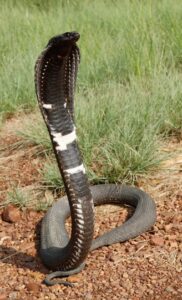
Rinkhals is considered an extremely venomous snake with venom having an LD50 value of 1.1 – 1.6 mg/kg and a yield of 100 mg per bite. It contains both neurotoxins and cytotoxins, which cause abdominal pain, drowsiness, bruising, nausea, pain and swelling in the bitten area, damage of tissues, vertigo, and vomiting. In the case of venom injected through a bite, necrosis can also occur.
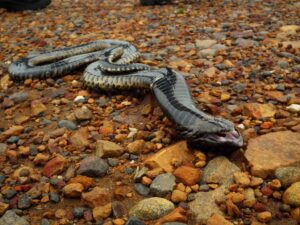
However, they are timid and prefer running away and hiding instead of attacking. But this is still a highly venomous species and should not be provoked. If the venom is spat in the human eye, it can cause a burning sensation, blurry vision, and even blindness; it can also destroy the cornea of humans and animals.
The fatality rate of this snake bite is very rare.
Rinkhals At a Glance
Distribution
Native to South Africa, their distribution ranges across Eastern and Western Cape provinces, the Free State, Kwazulu Natal, Lesotho, Mpumalanga, Transkei, Western Eswatini, and parts of Gauteng. They are ubiquitous in the Highveld region but do not occur in the Bushveld part of South Africa.
A small population also inhabits the town of Nyanga on the Zimbabwe-Mozambique border.
Habitat
Rinkhals prefer grasslands, marshy fields, shrublands, and swamps, mainly because these areas have abundant frogs. These snakes occur at an elevation of 8202 ft from sea level.
Lifespan
They live up to 20-25 years in the wild.
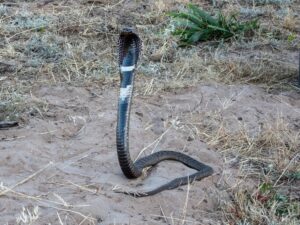
Predators
While the exact predators of this snake remain unknown, it can be assumed that they fall prey to the same threats other elapids face.
When threats feel too great, they rise up, spreading their hoods and even spitting venom. Due to poor aiming ability, they must fling their bodies toward the threat to ensure that the venom reaches their target; the sprayed venom can reach up to eight feet.
Sometimes, these snakes may pretend to be dead by staying still and turning on their backs with mouths open to ward off threats.
Diet
Frogs, toads, and rodents are the primary food source of these snakes; however, they also consume small birds and their eggs, lizards, and other snakes. Juveniles feed mostly on toad eggs and lizards.
After locating their prey, rinkhalses quickly grab it and inject their toxic venom, causing the prey to be paralyzed. Then they swallow it whole.
Reproduction
The breeding season starts in June and lasts through August. During this time, aggression increases in males, and they might engage in fights with each other for dominance.
Around late December to early March, ovoviviparous females give live birth to 20-35 individuals after 5-6 months of gestation. The highest recorded number of individuals being born was 65.
Newborns are precocial, measure approximately 6-7 inches, and are independent from birth. Juveniles reach their sexual maturity at 2-4 years old.
Similar Species
The Cape cobra is longer and has a less stocky body than the rinkhals.
Unlike rinkhalses, puff adders’ banding pattern appears V-shaped and occurs across the whole body.
Rinkhalses without their hood spread might appear similar to male boomslangs, especially the ones with black upper bodies and yellow bellies. However, while rinkhals possesses few cross bandings, the boomslangs’ entire underside is yellow.
FAQs
Ans: Rinkhalses and true cobras have different scale textures; while the former has ridged scales, the latter scales are smooth. There is also a difference in reproduction, the cobras lay eggs, and rinkhals gives live birth.
Ans: The rinkhals is mainly black to grey with yellow or orange bands, while the Mozambique spitting cobra has a dark to light brown, shiny body, with a black coloration between the scales and an orange-ish pink to yellowish belly with a dark band on it. They also have dark blotches on their throats.
Source
blogspot.com, africanreptiles-venom.co.za, turntable.kagiso.io, aboutanimals.com, gardenroutetrail.files.wordpress.com, a-z-animals.com, citizen.co.za, i.pinimg.com

